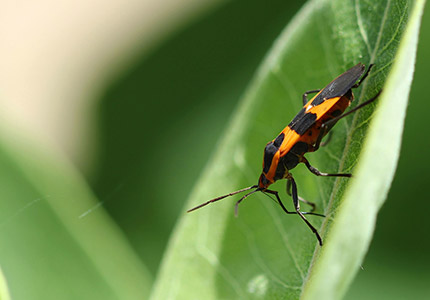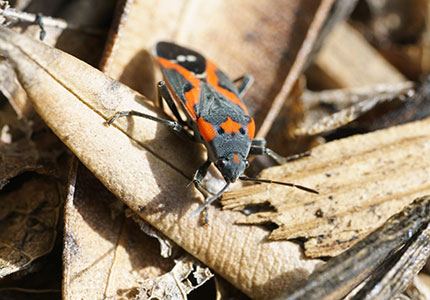Boxelder bugs are extremely common pests in the state of Utah.
These insects are considered a big nuisance pest, as they can reproduce quickly, but they do not cause much structural damage. These bugs are also not considered to be a health hazard to humans.
That being said, no one wants an infestation of any kind. In this article, you will learn more about Boxelder bugs and how to treat an infestation.
What do Boxelder bugs look like?

Both immature and adult Boxelders feed on fluid by piercing an object and sucking liquid out using mouthparts. On average, the adult Boxelder bug is ½ inches long, with an elongated oval shaped body that is flat on top. The outer body of this bug is solid, and will make a crunch if accidently stepped on. Boxelder bugs are dark grey to black in color, with three red lines that run along the back of the insect. Adults have wings, whereas nymphs (baby boxelder bugs) do not. Once the nymphs are about halfway grown, their wings will come in.
–
A day in the life of a Boxelder bug: Diet and nesting
As previously stated, Boxelder bugs feed on fluids by piercing an object and sucking the contents out. Some food sources for these bugs include seeds, foliage, fruit or twigs. Boxelder bugs have a preference for dry, sheltered areas. They are often found nesting along the foundation of homes, window panes, under leaves or other debris, bushes, in a ditch or similar locations. During the winter, Boxelders will stay in hiding to avoid the cold temperatures. In Spring, Summer and Fall seasons, they come out from hibernation to feed and breed. Since baby boxelder bugs prefer warm surfaces, you are likely to find a colony of them where it is hot and dry.
What are Boxelder bugs attracted to?

So, what exactly catches the eye of a Boxelder bug? Like I said before, these bugs are attracted to warm, dry areas. This plays a big part in why Utah has so many of these insects. Some homes are especially appealing to Boxelder bugs due to the amount of sun exposure they receive. Buildings with a substantial exposure to the south or west have been found to experience more Boxelder bug infestations. The color of a home does not appear to make any significant difference to these bugs. Since Boxelder bugs like to get their sun tan on, a nice sized flat surface would be this bug’s first choice.
How to eradicate / prevent a Boxelder bug infestation?
Prevention tips for all homes and structures:
- Install door sweeps or thresholds to all doors that lead to the exterior of the building.
- Install a rubber seal along the bottom of garage doors.
- Seal all windows with caulk, or for larger areas use polyurethane expanding spray foam.
- Repair or replace all damaged window screens and/or vents in the bathroom and kitchen.
- Seal rooms with cable TV wires, phone lines or any other utility wires. This includes sealing outdoor faucets, pipes and dryer vents.
- Repair any broken fans in the building.
If you think you may have a significant Boxelder bug infestation, calling an exterminator is your best option.
Fun Fact: Adult Boxelder bugs typically can fly several blocks, although in some cases they can travel as far as two miles.

